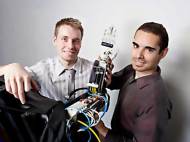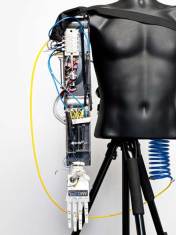Brain controlled Artificial Muscle-Operated (AMO) Arm
 Two Ryerson University undergraduate biomedical engineering students are developing a prosthetic arm that is controlled by brain signals. The Artificial Muscle-Operated (AMO) Arm is controlled by the user’s brain signals and is powered by ‘artificial muscles’ ( simple pneumatic pumps and valves) to create movements, unlike traditional prosthetic limbs which rely on complex and expensive electrical and mechanical components.
Two Ryerson University undergraduate biomedical engineering students are developing a prosthetic arm that is controlled by brain signals. The Artificial Muscle-Operated (AMO) Arm is controlled by the user’s brain signals and is powered by ‘artificial muscles’ ( simple pneumatic pumps and valves) to create movements, unlike traditional prosthetic limbs which rely on complex and expensive electrical and mechanical components.
Developed by third-year student Thiago Caires and second-year student Michal Prywata, the AMO Arm is controlled by the brain and uses brain signals that continue to occur even after a limb is amputated. Users wear a head-set that senses a signal and sends it wirelessly to a miniature computer in the arm. The computer compares the signal to others in a database and sends the resulting information to the pneumatic system, which in turn, activates the arm to create the according movement. Simulating the expansion and contraction of real muscles, the system makes use of compressed air from a small, refillable tank in the user’s pocket.
It took a year to develop the software program for the AMO Arm while the actual prototype was created during a marathon 72-hour design session. Unlike other prosthetic arms with a similar degree of control require a patient to undergo a complex muscle reinnervation surgery, the AMO Arm is non-invasive and the period of adjustment for new users is drastically decreased. While traditional prosthetics may require weeks of learning and training, the basic function with the AMO Arm can be mastered in mere minutes. According to its developers, the device costs one-quarter of other functional prosthetic arms (which can cost more than $80,000) because it does not include microelectronics and motors.
Caires and Prywata are working to move each finger on the AMO Arm individually. “Independent finger movements require many more sensors”, said Caires. “For example, while not impossible, it’s still quite difficult to grab a key and unlock a door.”
Although they are still students, Prywata and Caires are moving ahead on the commercialization of their innovations. They have formed their own company, Bionik Laboratories Inc., and are currently seeking three patents for the AMO Arm and their other technologies. Their recent acceptance into Ryerson’s Digital Media Zone (DMZ) will help them in achieving these goals.
“We were really impressed with the DMZ space initially, but didn’t know about all the resources at our disposal and the exposure it would afford us until we got here. The first day we arrived, we were meeting people, including CEOs and within a week we were shooting a piece for the Discovery Channel”, said Prywata.
In future, they plan to develop the AMO Arm further by making it able to sense different materials (e.g., an egg versus a full bottle of water) and adjust the applied force proportionately. They have already developed a concept for capacitive sensing which detects different materials prior to contact. They also plan to fit the tank into the arm itself and to develop an adaptive system, which would adjust to particular users through time.
AMO Arm will not only benefit amputees, but could also be used as an assistive device on wheelchairs, enabling users to reach objects with greater ease. The technology could also be used by the military to facilitate remote operations and in situations requiring robotics.










Leave your response!